“As the market fundamentals in seniors housing and care continue to trend positively since the COVID-19 vaccine became available, and operators are shifting gears from reacting to the threat of contagion in their communities to recovering census, many are finding their organizations returning to some form of operational normalcy in the face of considerable labor challenges. Wages and benefits are typically significant operating expenses for seniors housing and care providers even in the best of times. In the Wave 30 survey, about half of respondents reported that attracting community and caregiving staff was the biggest challenge their organizations are facing 16 months into the pandemic.Since the Wave 27 survey conducted in the latter half of April, the share of organizations experiencing staffing shortages in their properties has risen above 90%, and in the Wave 30 survey, four in five organizations (80%) with multiple properties have staffing shortages in more than half of their properties—up from two-thirds (64%) in Wave 29. In the July edition of the NIC Insider Newsletter, Beth Mace, NIC’s Chief Economist, considers a number of strategies to mitigate labor market challenges.”
–Lana Peck, Senior Principal, NIC
NIC’s Executive Survey of operators in seniors housing and skilled nursing is designed to deliver transparency into market fundamentals in the seniors housing and care space as market conditions continue to change. This Wave 30 survey includes responses collected June 14 to July 11, 2021 from owners and executives of 71 small, medium, and large seniors housing and skilled nursing operators from across the nation, representing hundreds of buildings and thousands of units across respondents’ portfolios of properties.
Detailed reports for each “wave” of the survey and a PDF of the report charts can be found on the NIC COVID-19 Resource Center webpage under Executive Survey Insights.
Wave 30 Summary of Insights and Findings
- Between one-half and more than two-thirds of respondents note that the pace of move-ins accelerated in the past 30-days. The shares of organizations reporting acceleration in the pace of move-ins were highest for the nursing care (70%) and independent living care segments (64%).
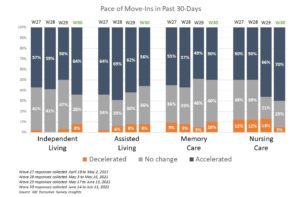
- Increased resident demand has been cited by nine out of ten respondents as a reason for acceleration in move-ins since the Wave 25 survey conducted in the latter half of March (around the time occupancy rates may have reached bottom). However, the Wave 30 survey suggests a slight pullback in the percent of respondents who see their leads volumes at pre-pandemic levels perhaps due to release of pent-up demand from the pandemic starting to wane as folks who had been previously waiting on the sidelines have been moving in since the spring. Currently, roughly one in four (27%) report lead volume at pre-pandemic levels compared to about one in three between May 3 and June 13 (35% and 34%, respectively). As shown in the chart below, before the vaccine was distributed, roughly 30% of organizations surveyed had a backlog of residents waiting to move in. As move-ins have increased, organizations with a backlog have decreased.
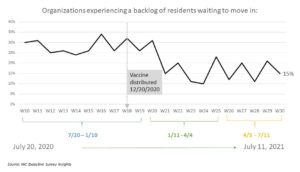
- The chart below illustrates the full time series of Executive Survey Insights data collected since near the beginning of the pandemic to July 11 regarding the pace of move-ins for the assisted living care segment. Looking across 30 waves of survey responses one can see the improvement in the pace of move-ins (blue segments) after the vaccine was distributed, in sharp contrast to the significant deceleration in the pace of move-ins witnessed earlier in the pandemic (orange segments) as operators halted admissions to protect lives.
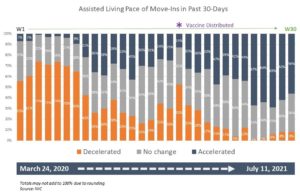
- Since mid-March, the average rates of community vaccinations have leveled off at around 65%. Despite reports from some operators that they will require employees to be vaccinated in line with vaccination policies already in place for influenza and other communicable diseases, only about one in five (21%) respondents in the Wave 30 survey indicate they likely will institute a staff COVID-19 vaccination mandate. Among those that definitely or probably will, more are not-for-profit providers.
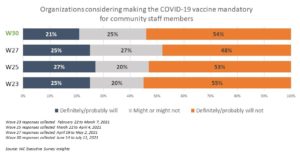
- Nursing care occupancy is still improving. Three-quarters of organizations with nursing care beds saw occupancy increases (76%); higher than about 40% of organizations with independent living, 50% of organizations with memory care, and 55% of organizations with assisted living residences.
- The share of organizations that expect their occupancy to return to pre-pandemic levels has remained consistent since the question was first asked in the latter half of February. In Wave 30, just under two-thirds of respondents (62%) anticipate occupancy will have rebounded by next year.
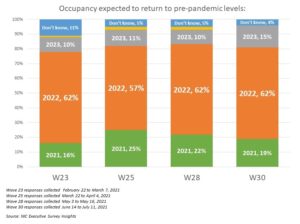
- Since the Wave 27 survey conducted in the latter half of April, the share of organizations experiencing staffing shortages in their properties has risen above 90%, and in the Wave 30 survey, four in five organizations (80%) with multiple properties have staffing shortages in more than half of their properties—up from two-thirds (64%) in Wave 29.
- Respondents were asked to rate the biggest challenge facing their organization today. In both Waves 29 and 30, around one-half (45%) indicated that attracting community and caregiving staff was their biggest challenge, followed by low occupancy rates and staff turnover.
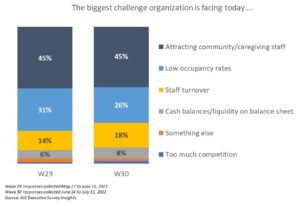
- Respondents were also asked to quantify the most effective method of attracting new community staff. Significantly, 63% indicated that increasing wages was most effective. In the July edition of the NIC Insider Newsletter, Beth Mace, NIC’s Chief Economist considers a number of strategies to mitigate labor market challenges.
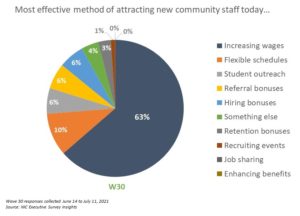
- Executive Survey Insights respondents have enthusiastically offered suggestions for new survey questions based on current conditions in the marketplace. These suggestions will continue to be included in future surveys from time to time. In the Wave 30 survey, the Paycheck Protection Program (PPP), an SBA-backed loan that helped businesses keep their workforce employed during the COVID-19 crisis, was explored. The program ended on May 31, and existing borrowers may be eligible for PPP loan forgiveness once all of the loan proceeds for which the borrower requested forgiveness have been used. If borrowers do not apply for forgiveness within ten months after the last day of the covered period, then PPP loan payments are no longer deferred, and borrowers will begin making loan payments to their lender.
- According to respondents to the Wave 30 survey, 70% of organizations received a PPP loan. About one-quarter, respectively, received $1M to $2M or more than $2M. The majority have applied for loan forgiveness (85%), and three-quarters have had their PPP loan forgiveness approved (none of the respondent organizations have been denied to date)
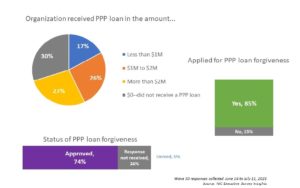
Wave 30 Survey Demographics
- Responses were collected between June 14 to July 11, 2021 from owners and executives of 71 seniors housing and skilled nursing operators from across the nation. Owner/operators with 1 to 10 properties comprise roughly half (56%) of the sample. Operators with 11 to 25 and 26 properties or more make up 44% of the sample (20% and 24%, respectively).
- Approximately one-half of respondents are exclusively for-profit providers (51%), and approximately one-half operate both not-for-profit (40%) and for-profit (9%) seniors housing and care organizations.
- Many respondents in the sample report operating combinations of property types. Across their entire portfolios of properties, 72% of the organizations operate seniors housing properties (IL, AL, MC), 41% operate nursing care properties, and 35% operate CCRCs (aka Life Plan Communities).
Owners and C-suite executives of seniors housing and care properties, please help us tell an accurate story about our industry’s performance.
The current survey is available and takes 5 minutes to complete. If you are an owner or C-suite executive of seniors housing and care and have not received an email invitation to take the survey, please contact Lana Peck at lpeck@nic.org to be added to the list of recipients.
NIC wishes to thank survey respondents for their valuable input and continuing support for this effort to bring clarity and create a comprehensive and honest narrative in the seniors housing and care space at a time when trends are continuing to change in our sector.
About Lana Peck
Lana Peck, former senior principal at the National Investment Center for Seniors Housing & Care (NIC), is a seniors housing market intelligence research professional with expertise in voice of customer analytics, product pricing and development, market segmentation, and market feasibility studies including demand analyses of greenfield developments, expansions, repositionings, and acquisition projects across the nation. Prior to joining NIC, Lana worked as director of research responsible for designing and executing seniors housing research for both for-profit and nonprofit communities, systems and national senior living trade organizations. Lana’s prior experience also includes more than a decade as senior market research analyst with one of the largest senior living owner-operators in the country. She holds a Master of Science, Business Management, a Master of Family and Consumer Sciences, Gerontology, and a professional certificate in Real Estate Finance and Development from Massachusetts Institute of Technology (MIT).
Connect with Lana Peck
Read More by Lana Peck